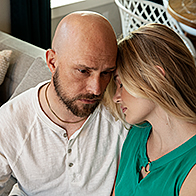Choosing the Optimal Couples Therapy Modality for You

Making the decision to begin couples therapy may inspire a range of emotions, from anxiety and dread to hope and relief. Choosing a therapist can prove daunting, even without the typical logistical challenges of scheduling and dealing with insurance companies.
The most important part of your decision is to identify a therapist who's a good fit for you and your partner. Not all therapists share the same approach: What works for some people might not work for others. To make that decision, you'll need to know the most common couples therapy modalities, what they're about and how they can help. You'll also need to note some considerations about individual therapists.
The Gottman method
One of the most common modalities for couples therapy is the Gottman Method, created by married psychologists John and Julie Gottman. Their approach is based on more than 40 years of research on couples they referred to as "the masters," who stayed connected and managed conflict well.
The Gottmans' foundational theory is something they call the "Sound Relationship House," which is a metaphorical framework for helping couples develop mutual understanding and shared meaning from their relationship. Trust and commitment are the "load-bearing walls" of the relationship.
Alexandra Luger, a Gottman-certified clinical psychologist in Illinois, said a therapist practicing pure Gottman therapy typically leads the couple through an intensive, thorough intake process, including meeting with the couple together as well as individually.
In much the same way as all therapists at this stage, your therapist synthesizes the data they've collected from the intake process to put together a treatment plan, working with the couple to see what they want to bring to the therapy.
The Gottman Method employs a number of tools to promote mutual connection and understanding, including encouraging couples to have a "State of the Union," or a recommended weekly check-in. During this period, couples can use intentional time to discuss one issue—such as the distribution of domestic tasks—as well as express gratitude for each other. Luger said the point of the exercise is to communicate the aspects that are lacking in the relationship, and to build an environment of fondness and admiration where partners can feel supported.
The Gottmans' foundational theory is something they call the 'Sound Relationship House,' where trust and commitment are the 'load-bearing walls' of the relationship.
In her experience, Luger explained that couples can sometimes struggle with the exercise because if they're in an entrenched pattern, this style of communicating can feel like a very unnatural way to talk to their partner. She said a therapist should be intentional about putting the exercise into context so couples feel affirmation for why they're doing it.
"Usually, it tends to be one person in the relationship who resists following an exercise because it feels a little too inorganic," Luger said. "I'll tell my patients that it's important to break the pattern and we have to slow things down and start from scratch, and generally, people will get there."
Luger also sees resistance when one person in the couple wants to come to therapy and the other person doesn't or is reluctant to talk about emotions. In this case, any intervention should prioritize establishing safety and building rapport to find out why a person is uncomfortable in therapy.
"That is probably a microcosm for a greater dynamic in their relationship, where one person wants to connect and work on the relationship or feels there are areas that need growth and that is not being acknowledged," Luger said. "At the very least, that person should explore individual therapy and how to manage that more generalized dynamic."
Preferably, both partners should be doing some individual work in addition to relationship work.
Sometimes, the resistance is born out of stigma or misunderstanding about what it means for the relationship if a partner wants to go to couples therapy. Luger said in those cases, she asks the person what their assumptions are about couples therapy and what coming to couples therapy means to them. If the idea feels too overwhelming, she usually suggests they read one of the Gottman books, such as "The Seven Principles for Making Marriage Work," which breaks down the theories behind the method in an accessible and non-stigmatizing way, she explained.
'You want to make sure it's a clinician who has intentionally been trained in couples work.'
Couples can use a vetted global referral network to find mental health professionals who are certified in the Gottman Method. Luger encouraged people who want to work with a Gottman therapist to check their level of certification, if they receive any kind of supervision (a sign that they are intentional about their learning, Luger advised) and whether they practice pure Gottman or incorporate other methodologies, such as emotionally focused therapy (EFT) or imago relationship therapy (IRT).
"That's not a bad thing, but you do want a therapist who can speak to what their methodology is," Luger said.
One key question Luger encourages couples to ask prospective therapists is what percentage of their caseload is couples versus individuals.
"A lot of graduate programs don't teach couples work as much as individuals," she said. "Unfortunately, it's not uncommon for therapists to start delivering couples therapy without solid training in that. You want to make sure it's a clinician who has intentionally been trained in couples work. Working with couples is not the same as working with an individual, and you can do a lot of damage if you don't know what you're doing."
Luger said the most important factor is for you and your partner to have a rapport and feel safe with the therapist so you feel comfortable having difficult conversations. If it doesn't feel like a good fit after a couple of sessions, it's OK to make a change.
"Too much shopping can be bad, but you don't have to stick to the first person you meet," Luger said.
Emotionally focused therapy
Sue Johnson is a British clinical psychologist working in Canada and professor emeritus in the psychology department at the University of Ottawa. Together with Les Greenberg—a fellow professor of psychology at York University in Toronto and director of the Emotion-Focused Therapy Clinic—she developed emotionally focused couples and family therapy in 1985. It's a psychotherapeutic approach for couples based on attachment therapy and, as the name implies, prioritizes emotion and emotional regulation in relationships. In addition to couples, EFT is an approach often used in family and individual therapy.
Sara Ruiz, an associate marriage and family therapist in San Diego, recommended EFT for couples who want to have a deeper, more intimate relationship but find themselves constantly fighting or feeling disconnected from each other. She explained that EFT can be difficult, as the process delves deeply into each individual's past experiences and relationships to determine how they have shaped who they are now.
Ruiz said one element that differentiates emotionally focused therapy from other therapy models is that it's experiential. She noted therapists typically don't give "homework," but rather focus on creating new levels of vulnerability and intimacy, and finding safety to apply that outside of sessions.
"It's really hard to trust the process in my head because I want to give my clients tips and tricks, but that's not what creates change," Ruiz said. "What creates change is accessing those fears and attachment needs and creating safety in the relationship."
Ruiz said green flags for a prospective therapist are empathy and the abilities to be present with you in moments of pain and make you feel validated.
The ability to de-escalate is also critical. A good couples therapist should be able to manage an argument so it does not derail the session and help repair any disconnection that happens in the session.
"I think it's our job as therapists to get in the mix and slow it down and not let the couple do what they do at home," Ruiz added. "It's pointless to go to therapy and fight like you do at home."
Every therapist is different, but Ruiz said she needs couples to be willing to take risks in the relationship. Emotionally focused therapy can be effective for reconnecting as well as helping individuals heal from past trauma. But if a therapist uses strict EFT, they may encounter couples where one or both partners are unwilling to risk being vulnerable out of fear of how the other will respond.
"They may say, 'If I tell them my vulnerability, they're going to reject me,'" Ruiz said. "We work with those blocks."
Ruiz noted that if there are issues of domestic violence or physical harm in the relationship, she is unable to start working with that couple.
"We have to ensure that there's physical safety before there's emotional safety," she explained.
Ruiz advised couples interested in exploring EFT to get to know their therapist and ensure both partners can trust them.
"If you can imagine you're hiking through a jungle, what kind of guide do you want guiding you through?" Ruiz asked. "That's what EFT therapy says. We are walking through the jungle of your past and the trauma and your hurt. Do you trust this person, that you can walk with them and they're not going to leave you in this process?"
Imago relationship therapy
When Emilio Anguiano, an imago relationship therapist based in Austin, Texas, talks about the method, he likes to start by defining the root of the word "imago." The method was introduced in 1980 by Harville Hendrix and Helen LaKelly Hunt, and the name comes from the Latin word for "image," referring to the "unconscious image of familiar love."
The imago method seeks to connect conflicts in adult relationships with the partners' childhood experiences, for example, examining how a person whose parents heavily criticized them as a child would be sensitive to criticism from a partner as an adult.
"From imago, we bring all these experiences from childhood, positive and negative, healthy and unhealthy, in an unconscious way," Anguiano explained. "When we grow up and get into relationships, all this hidden luggage in our bags is going to show eventually and it's going to impact the way that we connect with others, the kind of person we are going to choose and how we're going to approach love, marriage, dating and relationships."
Anguiano said the cornerstone of imago is promoting safe conversations, which are ideal for couples who want to work on their communications skills. He noted that clients can expect to work on really listening to what their partner is saying, instead of their own projections, and validating their partner's experiences.
The imago method seeks to connect conflicts in adult relationships with the partners' childhood experiences.
"It requires a lot of intentionality and a lot of willingness on my own to regulate myself and provide some validation from you," Anguiano explained. "It requires empathy: me being curious about your feelings, honoring your feelings and helping to identify and to name these feelings."
Anguiano recommended asking for a free consultation and doing at least two or three preliminary interviews before choosing an imago therapist. He said it's important to discuss the basics, such as logistics, availability, fees, proper licensing in your state and if they have imago certification that can be verified online.
From there, he suggested asking about the general concepts or cornerstones the therapist takes into consideration when helping couples. Green flags include listening without judgment, validating the experiences of the client or the relationship, being attuned to the needs of the couple and being ready to assist with any activation or trigger that comes up.
Additionally, Anguiano noted he works with couples where one or both partners may be struggling with or in recovery from addiction. An imago therapist is unlikely to reject a couple dealing with those issues.
"A traditional model will tell you if your partner is drinking, they need to go to rehab, and then the couples therapy can start months later or years later," he explained. "From imago, what we say is the opposite of addiction is not sobriety, it's connection. We don't need to wait until one of them goes to rehab because we know it's a long process."
Other methods and modalities
These three approaches are far from the only ones available to a couple seeking therapy.
Narrative therapy explores how couples derive meaning from their stories and experiences, focuses on separating individuals from their problems, and empowers people to be the experts in their own life experiences.
Discernment counseling is another potential option when one partner is unsure they want to remain in the relationship and doubtful couples therapy can help. This practice focuses on ensuring both parties are equally supported and "accepts ambivalence rather than trying to work around it or overcome it," according to DiscernmentCounseling.com.
Another popular option is a psychobiological approach to couple therapy (PACT), developed by clinician Stan Tatkin, Psy.D., M.F.T. Originating in Calabasas, California, this therapy focuses on the shifts in your face, body and voice as you work through similar experiences to those troubling your relationship in real time during the session.
The specific couples therapy modality is just one of many considerations a couple should make when deciding to start professional work on their relationship. Does the therapist have experience and competence in working with clients who are Black, Indigenous, people of color or part of the LGBTQIA+ community? Resources such as Inclusive Therapists and the National Queer and Trans Therapists of Color Network can be helpful for finding mental health professionals who understand your specific experiences and can support you.




















